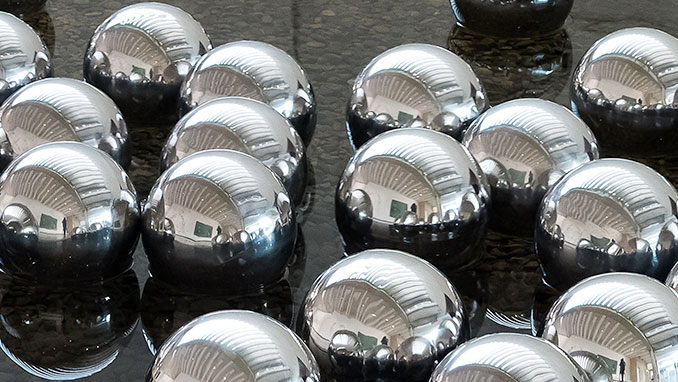 Launching their bold, expansive and thought-provoking 2021 theme, Reflections on identity, the Museum of Sydney presents Narcissus Garden by Yayoi Kusama, one of the most significant artists of the 20th century, from Saturday 20 February.
Launching their bold, expansive and thought-provoking 2021 theme, Reflections on identity, the Museum of Sydney presents Narcissus Garden by Yayoi Kusama, one of the most significant artists of the 20th century, from Saturday 20 February.
In Narcissus Garden, mirrored balls reflect each other and their onlookers, creating an infinitely recurring web in which the surrounding visible world is trapped and perpetuated. Evoking the mythological figure of Narcissus, this work allows viewers to see themselves and the world around them.
Narcissus Garden has seen many incarnations over more than 40 years. It first appeared in 1966 at the Venice Biennale, where the artists, though uninvited, installed 1500 plastic reflective balls on the grass outside the Italian pavilion.
Her attempts to sell the balls, a deliberate critique of the commercialisation of the art world, led to her expulsion from the show. In stark contrast, nearly thirty years later in 1993, Kusama was the first individual artist and only woman to officially represent Japan in its pavilion at Venice.
For the first time, Narcissus Garden will launch at the Museum of Sydney, before taking over the drawing room and fountain at Vaucluse House (24 April – 23 May) and – for Sydney Living Museums members only – the library at Elizabeth Bay House (from late May).
This is a rare opportunity to see this extraordinary and timeless work in historic spaces, where the balls will capture the trappings of colonial wealth and taste, and inspire each of us to consider how we are, or are not, mirrored in these spaces and their history.
Yayoi Kusama is one of the most significant artists to emerge from Asia in the postwar period. Kusama was born in Matsumoto, Nagano prefecture, Japan in 1929 and was the youngest of four children. By 1941, as a twelve-year-old child, she had begun to notate and paint hallucinations, which she experienced as veils of dots.
During the early 1950s, Kusama recognised that the visual and aural hallucinations she had experienced for a decade were symptomatic of a condition known as ‘rijin’sho’ (depersonalisation syndrome). Kusama continues to experience these hallucinations to this day.
As an adult Kusama developed a vibrant visual iconography composed of dots, often transposed as nets or auras, that has become the familiar visual vocabulary dominating her artistic practice. Kusama moved to New York in 1955, where she lived and worked until 1972, before returning to Japan.
Kusama’s practice embraces drawing, painting, collage, sculpture, performance, fashion, tabloid publishing, filmmaking, installation, novels, poetry and music.
Narcissus Garden
Museum of Sydney, Corner Phillip and Bridge Streets, Sydney
Installation: 20 February – 18 April 2021
Admission charges apply
Following its presentation at the Museum of Sydney, Narcissus Garden will be presented at Vaucluse House (24 April – 23 May) and Elizabeth Bay House (from late May). For more information, visit: www.sydneylivingmuseums.com.au for details.
Image: Narcissus Garden (detail), Yayoi Kusama 1966/2002. Gift of the artist through the Queensland Art Gallery Foundation. 2002 Collection, Queensland Art Gallery | Gallery of Modern Art © Yayoi Kusama Picture © Natasha Harth, QAGOMA
